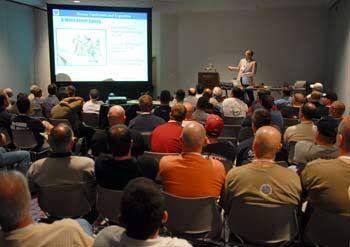| Click here for full coverage from the 2006 FireRescue Conference and Expo |
By Crawford Coates
Assistant Editor, FireRescue Magazine and Wildland Firefighter
 Buffalo (N.Y.) Fire Dept. Chief and FireRescue Magazine contributor Peter Kertzie led a session Thursday on chainsaw use titled, “Make the Cut: Chainsaw Training and Safety.” Focused on addressing the general lack of formal chainsaw training programs at many fire departments, Kertzie provided a number of valuable tips and techniques for safe and smart chainsaw operations. Here are some of them:
Buffalo (N.Y.) Fire Dept. Chief and FireRescue Magazine contributor Peter Kertzie led a session Thursday on chainsaw use titled, “Make the Cut: Chainsaw Training and Safety.” Focused on addressing the general lack of formal chainsaw training programs at many fire departments, Kertzie provided a number of valuable tips and techniques for safe and smart chainsaw operations. Here are some of them:
Training
• Once in a while, train in turnout gear with your SCBA, just to grow accustomed to working on pitched roofs in full gear, since this is how you will be dressed when the call comes in at 4:30 in the morning.
Chains
• Treat your chain well, and remember to break it in first. Chains treated well will be able to make dozens of cuts. When you first put the chain on, run the saw and let it heat up, then adjust as necessary. Also, it’s important to remember that chains are not interchangeable between different brands of saws.
• When the chain doesn’t cut easily, it might be a sign that it is bad and needs maintenance or replacement. Examine it and keep in mind that tar can gum the teeth up. Soak the chain in solvent to remove tar and reexamine.
Saw Start-up
• When you start up a chain saw, do so with the saw on the ground or held securely between your legs.
• Carry the saw on your back. If you are near the fire, start it first and keep the guard on to carry it to the fire. Otherwise, start it up at the staging area.
Cutting the roof
• If you feel resistance, you might be cutting a rafter; move the saw over a couple of inches and, if necessary, remove a rafter. Removing one rafter isn’t a big deal and it makes access for overhaul much easier. Consider using two saws simultaneously and remember that cuts don’t need to be square or pretty, so overlap them or remove many small pieces, as is easiest.
• Fire service saws are meant to run fast: 100-124 feet per second. Running the chain quickly saves the blade. Also, stones in roof shingles kill the blade, so plunge these roofs quickly.
• When going to ventilate a peaked roof, the saw is just one of the pieces of equipment you should carry. Additionally, have hand-tools ready. That said, even if you are physically able to vent a roof with hand-tools alone, you will be tired after doing so. The saw makes bigger cuts and is a better option.
Finishing up
• When done with a saw, don’t put it away. Put it on the bumper and service it at the scene. If this is not possible, place it in the cab so that you don’t forget to service it.
• After heavy use, take the saw apart and be sure to have the owner’s manual with you. Take the guard off, remove the bar, clutch cover, and chain. Flip the bar.
• Clean pitch off the bar with a painter’s scraper and spray dirty areas with a cleaner. Clean the fins and oil slot. Grease the bar and holes. Be careful not to put the chain in backwards.
Safety
• When carrying a saw, exaggerate the ladder angle to compensate for weight. Cut long, thin ventilation holes rather than squares and don’t overextend trying to do so. Saw depth should be just enough to penetrate the roof, but err on going a little deeper so that you don’t need to re-cut. Cut along the ladder edge last, letting gravity pull the saw down. When done, secure the saw to the ladder so that it doesn’t fall and hurt someone.
• Use eye protection. SCBA face pieces will work.
• The biggest threat with chainsaws is ear damage, so make sure to protect your ears.
Peter F. Kertzie has been with the Buffalo New York Fire Department for 17 years, where he is currently a captain assigned to Truck-14.











